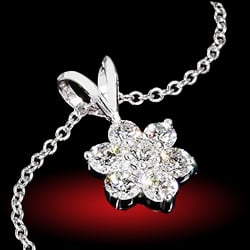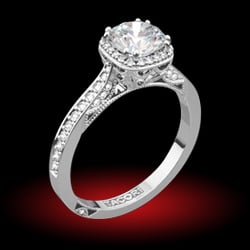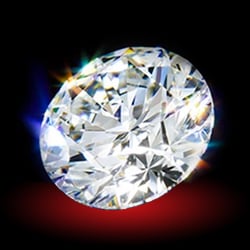You are using an out of date browser. It may not display this or other websites correctly.
You should upgrade or use an alternative browser.
You should upgrade or use an alternative browser.
Guesses on wholesale cost?
- Thread starter slycatty
- Start date
- Status
- Not open for further replies. Please create a new topic or request for this thread to be opened.
- Joined
- Apr 3, 2004
- Messages
- 33,852
just my guess...nowadays the internet vendors would be happy to make a 10% profit. the 50% mark up days are long gone.Date: 3/23/2010 10:48:32 PM
Author:slycatty
Lets say a diamond is selling for 15k from a pricescope vendor. How much do you think the vendor paid for the stone? How much do you think the wholesaler paid for the stone?
L
Lula
Guest
I think it really varies, depending on the original cost of the rough, the final carat size, color, clarity, type of certification, etc. If it was a $15,000 D IF 1.00 AGS 0 cut, for example, compared to a 2 carat J I1 stone with an EGL certification (just making these numbers up for comparison). I'd "guess" that the profit margin on the J I1 stone would be lower than the D IF stone because the marketplace places a higher dollar value on high color and clarity (that's why stores emphasize color and clarity over cut). Just a pure guess.
- Joined
- Apr 30, 2005
- Messages
- 34,634
- Joined
- Apr 3, 2004
- Messages
- 33,852
would it shock you if i said...it is possible for the cutter to lose money?Date: 3/23/2010 11:18:00 PM
Author: slycatty
My guess(total guess) is that the wholesaler paid 9k for the stone and sold it to the online vendor for 13k.
- Joined
- Apr 30, 2005
- Messages
- 34,634
- Joined
- Aug 14, 2009
- Messages
- 27,501
- Joined
- Sep 3, 2000
- Messages
- 6,756
I have seen vendors compete to make a big Internet sale where they made $100 on a $10,000 sale. I have also seen that sometimes it looks as if a vendor has made upwards of 30% on a sale, but it isn''t the common range of profit. Profits tends to be in the 8% to 20% range and possibly the wide variance is based on my own mistaken calculation of the actual cost on individual diamonds. I can''t tell for sure what any single diamond really costs a vendor, but I can judge the normal range of cost and make some hypothtical expert guess at profit on a stone. That''s the best that can be done if you are going to generalize about profits based on secret actual costs.
Diamonds vary in cost due to how they enter the marketplace. Are they full cost, brand new diamonds? Was the cost of the rough a great deal, or was the rough a little more costly than expected. Did the cutter retain more weight than planned, or less weight? Was the diamond purchased second hand from an estate at a bargain price or did the competition drive the bidding up high for a rare stone? What service level does the vendor provide? Are they a place that gives clients every little tool and a super fine box, or are they a plain drop shipper with little to no overhead?
Just like going out for dinner, you can look at the cost of food as being relatively the same for most restaurants, but the cost of the atmosphere, the ambiance, the level of service, the uniforms, the carpets, the amenities, etc, all play into what you''ll be asked to pay for dinner. The profit margin might be higher in a less costly restaurant or may be higher in a fine place. You simply can''t know how each place is doing without a deep investigation of their overhead and volume. The fancy place will charge you more, but they may be making less. How much you enjoy the transaction, diamonds or dinner, is a matter of your own taste and budget.
Diamonds vary in cost due to how they enter the marketplace. Are they full cost, brand new diamonds? Was the cost of the rough a great deal, or was the rough a little more costly than expected. Did the cutter retain more weight than planned, or less weight? Was the diamond purchased second hand from an estate at a bargain price or did the competition drive the bidding up high for a rare stone? What service level does the vendor provide? Are they a place that gives clients every little tool and a super fine box, or are they a plain drop shipper with little to no overhead?
Just like going out for dinner, you can look at the cost of food as being relatively the same for most restaurants, but the cost of the atmosphere, the ambiance, the level of service, the uniforms, the carpets, the amenities, etc, all play into what you''ll be asked to pay for dinner. The profit margin might be higher in a less costly restaurant or may be higher in a fine place. You simply can''t know how each place is doing without a deep investigation of their overhead and volume. The fancy place will charge you more, but they may be making less. How much you enjoy the transaction, diamonds or dinner, is a matter of your own taste and budget.
ChunkyCushionLover
Ideal_Rock
- Joined
- Jun 21, 2009
- Messages
- 2,463
Great post and your range fits the conclusion I have drawn when comparing wholesale lists with that of some of the PS vendors.Date: 3/24/2010 9:45:18 AM
Author: oldminer
I have seen vendors compete to make a big Internet sale where they made $100 on a $10,000 sale. I have also seen that sometimes it looks as if a vendor has made upwards of 30% on a sale, but it isn't the common range of profit. Profits tends to be in the 8% to 20% range and possibly the wide variance is based on my own mistaken calculation of the actual cost on individual diamonds. I can't tell for sure what any single diamond really costs a vendor, but I can judge the normal range of cost and make some hypothtical expert guess at profit on a stone. That's the best that can be done if you are going to generalize about profits based on secret actual costs.
Diamonds vary in cost due to how they enter the marketplace. Are they full cost, brand new diamonds? Was the cost of the rough a great deal, or was the rough a little more costly than expected. Did the cutter retain more weight than planned, or less weight? Was the diamond purchased second hand from an estate at a bargain price or did the competition drive the bidding up high for a rare stone? What service level does the vendor provide? Are they a place that gives clients every little tool and a super fine box, or are they a plain drop shipper with little to no overhead?
Just like going out for dinner, you can look at the cost of food as being relatively the same for most restaurants, but the cost of the atmosphere, the ambiance, the level of service, the uniforms, the carpets, the amenities, etc, all play into what you'll be asked to pay for dinner. The profit margin might be higher in a less costly restaurant or may be higher in a fine place. You simply can't know how each place is doing without a deep investigation of their overhead and volume. The fancy place will charge you more, but they may be making less. How much you enjoy the transaction, diamonds or dinner, is a matter of your own taste and budget.
I would also add it is a little more difficult to generalize when dealing with branded lines of diamonds where the (Final Cost - (Cost from Cutter, Shipping and Certification)) may indeed be 25-35% or more but there are other variable costs(like sending back stones for recut) that are not factored into that simple formula.
Regards,
CCL
- Joined
- Jul 21, 2004
- Messages
- 9,159
Calculating 'wholesale' is a curiously difficult thing, especially if the issue is what are the cutters costs up to the point of their sale. They buy a piece of rough through what amounts to an auction and estimate what they think the results are going to be on a particular job. If they win the stone they pay some workmen to cut it, ship it around a bit, pay some taxes, pay a lab and then put it up for sale. This is where the first tricky point comes in. If their estimate is wrong, they take a hit, if it comes out better than they expected they get a bonus. Since they’re competing with each other to buy the rough, there’s a fair amount of skill involved in estimating conservatively enough that they make a profit and generously enough that they actually get the stone. The process takes a few months to complete. They pay up front and if you’ve got a decently large operation then there’s a significant financial exposure.
They then offer the stone(s) for sale. How well this goes is another competitive marketplace and it has to do with both the details of the stone and the condition of the marketplace. This is important because they are potentially competing against roughly every stone that has ever been mined. They pitch the merits of their own deal and the dealers shop them against one another. There are large global databases, not unlike Pricescope where they flog their stones and, hopefully, a particular stone will sell well and for a good profit. If it does they repeat the process and if it doesn’t they go find a different job. Antwerp is full of diamond cutters working at coffee shops in the same way that Hollywood is full of actors delivering pizzas, waiting for their ship to come in. There are a few that are making money at it but, for the most part, it’s a high risk and low profit sort of business. On average I would be surprised if they are typically seeing more than a 10% yield even though on certain stones it’ll be a lot more than that and on some it’s going to be a loss.
‘Wholesalers’ have a similar situation. The cutters are usually anxious to get their money so that they can reinvest in new rough and this creates a market for dealers who are willing to take the stone into inventory, list it for sale for weeks, months or years until someone comes along who really needs it and they then get to sell it off at a profit. How much profit? It depends on the stone and how well they did buying. These are arbitragers in the truest since of the word. It’s possible to make a killing here and it’s possible to lose your shirt. These folks are pretty closed lipped about how things are going but, in general, they don’t seem to be terribly happy these days. Sales are getting harder to find , costs are rising from the cutters (because of the cost of rough), and credit is tight. Patience will surely win out for them in that diamonds aren’t exactly perishable and people are likely to continue to be interested in buying them but, for now, this is a tough way to make a buck. Bankruptcy is increasingly common in this sector and these guys are starting to find the need to get real jobs too. Some are becoming retailers, some are just sitting on their inventory until things improve and some are selling off the stock to their ‘competitors’ (who are sitting on it).
Last in the chain is the retailers. They mostly aren’t carrying stock and will order in a stone from the folks in the previous paragraph as needed when a customer expresses interest. They’ll vary from a few percent to as much as 30-50% markup depending on the details of the stone and the deal at hand. As mentioned above, the ‘full service’ type outfits have more expenses and need higher prices than the discount drop shippers. This is another category that’s suffering right now. The big traditional jewelry stores are closing up shop for the simple reason that asking the big prices isn’t the same as getting them and the expenses, like mall rents and salaries for the staff tend to be fixed costs that you have to pay whether or not you are actually making sales. Actually making the sale is hotly competitive and, like David, I routinely see offers where I think the dealer is working on single digit margins.
Notice by the way that I didn’t answer your question. The problem is in defining what is ‘wholesale’. Aside from the fact that not all dealers pay the same prices for their merchandise, and a particular stone will be traded at different prices under different circumstances, it’s not even clear who is a wholesaler. Many jewelers, perhaps most, use that word to describe themselves. As a consumer, the way to address this problem is simple. Pay attention to the details at hand, not so much to how the dealer describes themselves, where and how they say they got the stone. It doesn’t really matter if the cutter made any money on your particular stone or even how many hands it passed through before it got to you. What matters is what it is and what the deal is costing you.
Neil Beaty
GG(GIA) ICGA(AGS) NAJA
Professional Appraisals in Denver
They then offer the stone(s) for sale. How well this goes is another competitive marketplace and it has to do with both the details of the stone and the condition of the marketplace. This is important because they are potentially competing against roughly every stone that has ever been mined. They pitch the merits of their own deal and the dealers shop them against one another. There are large global databases, not unlike Pricescope where they flog their stones and, hopefully, a particular stone will sell well and for a good profit. If it does they repeat the process and if it doesn’t they go find a different job. Antwerp is full of diamond cutters working at coffee shops in the same way that Hollywood is full of actors delivering pizzas, waiting for their ship to come in. There are a few that are making money at it but, for the most part, it’s a high risk and low profit sort of business. On average I would be surprised if they are typically seeing more than a 10% yield even though on certain stones it’ll be a lot more than that and on some it’s going to be a loss.
‘Wholesalers’ have a similar situation. The cutters are usually anxious to get their money so that they can reinvest in new rough and this creates a market for dealers who are willing to take the stone into inventory, list it for sale for weeks, months or years until someone comes along who really needs it and they then get to sell it off at a profit. How much profit? It depends on the stone and how well they did buying. These are arbitragers in the truest since of the word. It’s possible to make a killing here and it’s possible to lose your shirt. These folks are pretty closed lipped about how things are going but, in general, they don’t seem to be terribly happy these days. Sales are getting harder to find , costs are rising from the cutters (because of the cost of rough), and credit is tight. Patience will surely win out for them in that diamonds aren’t exactly perishable and people are likely to continue to be interested in buying them but, for now, this is a tough way to make a buck. Bankruptcy is increasingly common in this sector and these guys are starting to find the need to get real jobs too. Some are becoming retailers, some are just sitting on their inventory until things improve and some are selling off the stock to their ‘competitors’ (who are sitting on it).
Last in the chain is the retailers. They mostly aren’t carrying stock and will order in a stone from the folks in the previous paragraph as needed when a customer expresses interest. They’ll vary from a few percent to as much as 30-50% markup depending on the details of the stone and the deal at hand. As mentioned above, the ‘full service’ type outfits have more expenses and need higher prices than the discount drop shippers. This is another category that’s suffering right now. The big traditional jewelry stores are closing up shop for the simple reason that asking the big prices isn’t the same as getting them and the expenses, like mall rents and salaries for the staff tend to be fixed costs that you have to pay whether or not you are actually making sales. Actually making the sale is hotly competitive and, like David, I routinely see offers where I think the dealer is working on single digit margins.
Notice by the way that I didn’t answer your question. The problem is in defining what is ‘wholesale’. Aside from the fact that not all dealers pay the same prices for their merchandise, and a particular stone will be traded at different prices under different circumstances, it’s not even clear who is a wholesaler. Many jewelers, perhaps most, use that word to describe themselves. As a consumer, the way to address this problem is simple. Pay attention to the details at hand, not so much to how the dealer describes themselves, where and how they say they got the stone. It doesn’t really matter if the cutter made any money on your particular stone or even how many hands it passed through before it got to you. What matters is what it is and what the deal is costing you.
Neil Beaty
GG(GIA) ICGA(AGS) NAJA
Professional Appraisals in Denver
- Status
- Not open for further replies. Please create a new topic or request for this thread to be opened.
Share:
The Ultimate Guide to Men’s Wedding Bands: Metals, Fit & Finish
The Ultimate Guide to Men’s Wedding Bands: Metals, Fit & Finish - 06/27
Chipped Diamonds: Causes, Risks, and What You Should Do About It
Chipped Diamonds: Causes, Risks, and What You Should Do About It - 06/27








300x240.png)